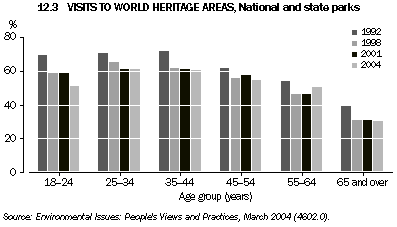NATIONAL PARKS
National parks and other protected areas are areas of land and/or sea especially dedicated to the protection of biodiversity and other natural and cultural resources. They are established under Commonwealth, state or territory laws or other legal means. All governments participate in the development of a comprehensive, adequate and representative national reserve system as part of Australia's obligation under the United Nations Biodiversity Convention established in 1993. Most national parks and other protected areas in Australia are declared and managed by state and territory governments although, during the last decade, some protected areas have been established which are managed by conservation or other groups. Declaration and management of Indigenous protected areas - Indigenous-owned land that is managed to protect its natural and associated cultural values - commenced in 1998. The Australian Government declares and manages parks and reserves on land owned or leased by the Commonwealth, in Commonwealth waters and on Indigenous land leased to the Commonwealth.
Although there are nearly 50 different protection designations in Australia, all protected areas are classified into one or more of the IUCN protected area management categories (<http://www.deh.gov.au/parks/iucn.html>), the most common being 'national park' and 'nature reserve'. The types of areas managed include: strictly protected areas managed mainly for science with very limited public access; areas where recreation is encouraged, but where resource development adverse to conservation of the environment is not; and multiple use areas where ecologically sustainable resource utilisation, recreation and nature conservation can coexist. Table 12.2 shows the total area protected for each IUCN category for each state and territory in Australia.
Lists and descriptions of the parks and reserves managed by Australian, state and territory governments can be accessed using links on the Parks and Reserves page of the Department of Environment and Heritage web site at <http://www.deh.gov.au/parks>.
VISITS TO WORLD HERITAGE AREAS, NATIONAL AND STATE PARKS
The ABS Environmental Attitudes and Practices Survey is a household survey collecting data on several environmental topics, including visits to World Heritage areas, and national and state parks. The most recent survey found that people aged 25-34 years or 35-44 years were the most likely to have visited these areas and parks in the 12 months prior to March 2004. During that period, for both age groups, just over 60% of people visited one of these areas compared with 52% for the adult population as a whole. With a visit rate of 31%, people aged 65 years or over were the least likely to have visited these areas.
Graph 12.3 shows visit rates have tended to decline between 1992 and 2004 within each age group. For the 2004 survey, the overall adult visit rate dropped to 52% from the 54% recorded for 2001. The age group contributing most to the overall fall in the visit rate was the 18-24 year-olds. For this age group, the visit rate declined from 59% for the 2001 survey to 51% for 2004.

Of those people who had not visited a World Heritage area, national or state park in the 12 months prior to March 2004, 36% cited lack of time as the main reason for this. Lack of time was the most common main reason for not visiting for all age groups except people aged 65 years and over, for whom age or health conditions was the most common main reason. People aged 25-34 years and people aged 35-44 years had the highest incidences of lack of time being the most common main reason (both 49%).
Inability to visit because of age or health conditions was the second most common main reason for not visiting (17% overall, and 53% of people aged 65 years and over).
 Print Page
Print Page